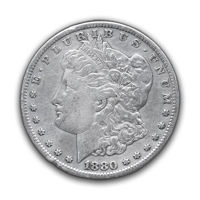Posted on August 25, 2021

As one of the most coveted and popular collectors’ items for coin collectors, the Morgan silver dollar has a special place in the hearts of numismatic and silver coin enthusiasts. These coins, which were once commonplace in American society, are now much rarer. Let’s examine why this is and how the Morgan Dollar became such a highly coveted coin.
Minted from 1878-1904 and then again in 1921, the Morgan silver dollar was the United State’s first standard silver dollar coin in circulation. Designed by George T. Morgan, the coin depicts lady liberty on the front along with the year of minting and an eagle with outstretched wings on the reverse side. The reverse side also displays the mint mark to identify where the coin was minted.
The coins — which are composed of 90% silver and 10% copper — were first minted in Philadelphia as it was the only mint in the country which had the proper equipment to prepare the die of each coin. Later, dies were sent to other mints throughout the country, which would then go on to mint the Morgan for circulation.
All told, the U.S. minted 657 million Morgan silver dollars. But most of these coins are gone forever, melted down in an act of Congress that would change the silver landscape forever.
 Proposed by Nevada Senator Key Pittman, The Pittman Act would affect the fate of the Morgan silver dollar forever. This piece of legislation authorized the U.S. federal government to convert up to 350 million circulating silver dollars into bullion for sale. These Morgan dollars were melted down and completely destroyed in this “great meltdown.”
Proposed by Nevada Senator Key Pittman, The Pittman Act would affect the fate of the Morgan silver dollar forever. This piece of legislation authorized the U.S. federal government to convert up to 350 million circulating silver dollars into bullion for sale. These Morgan dollars were melted down and completely destroyed in this “great meltdown.”
To replace the coins that were going out of circulation, the U.S. then purchased silver from domestic companies to be minted into new coinage. However, the Morgan dollars melted down were never fully replaced as the Peace dollar replaced the Morgan dollar in 1921.
The reason for this action was to help European nations finance their World War I operations so that they could equip better for the war. Great Britain was experiencing inflation that it could not control, and if not for the sale of silver by the U.S., it would have been difficult for the country to finance its wartime efforts.
As a result of the Pittman Act, more than 270 million Morgan silver dollars were melted down into bullion and exported for sale. This Act left only approximately 80 million Morgan dollars in circulation, some of which were destroyed in subsequent meltings throughout the first half of the 1900s.
While the Pittman Act drove many Morgan Dollars out of circulation, two other factors contributed to the rarity of this coin. For one, silver is an excellent store-of-value commodity; those with silver coins like the Morgan dollar decided to hold on to them instead of spending them at their $1 face value. Second, the Morgan dollar stopped being minted in 1921 when it was replaced by the Peace dollar, further causing collectors to hoard circulating examples of the Morgan.
This is a prime example of Gresham’s Law, which states that the best forms of money are those whose face value is closest to its commodity value. (In other words, “bad money drives out the good.”) Seeing that the value of silver was increasing, holders of Morgan Dollars and silver coins hoarded those with a higher melt value, thereby removing many of the remaining coins in existence from circulation.
When it comes to Morgan Dollars, there are a few variations of the coin considered the rarest of the bunch. The uncirculated 1895 Morgan Dollar is often referred to as the “King of the Morgan Dollars.” In fact, one of these pieces sold for $269,500 in 2020. It’s believed that only about 800 of these coins were ever struck, leaving collectors to salivate over their rarity.
The 1884 Morgan silver dollar is also high on collectors’ wish lists. But not all 1884 silver dollars are created equal. Those struck at the Carson City mint are considered rarer because that mint produced only a small quantity of Morgan Dollars. These Carson City Morgans mint-marked CC often sell for three or four times the value of similar coins struck the same year at other U.S. mints.
Lastly, there was confusion about how many tail feathers the eagle depicted on the Morgan Dollar should have. The coin was initially produced depicting eight tail feathers on the eagle and later changed to seven tail feathers. Those coins with seven tail feathers — often referred to as 7TF — are more valued by collectors.
As numismatic enthusiasts scour the globe for Morgan Dollars, it’s important to be able to identify an authentic Morgan Dollar from a counterfeit, as well as it's quality. The quality of Morgan Dollars can be identified based on its grade on the Sheldon Scale (just like all numismatic coins). Grades on this scale range from 1 (Poor) to 70 (Mint State), with varying degrees of quality in between.
As previously mentioned, the mint mark of a Morgan Dollar can play a big role in its rarity, and therefore value. So always be sure to identify the mint mark of any Morgan Dollar you may come across.